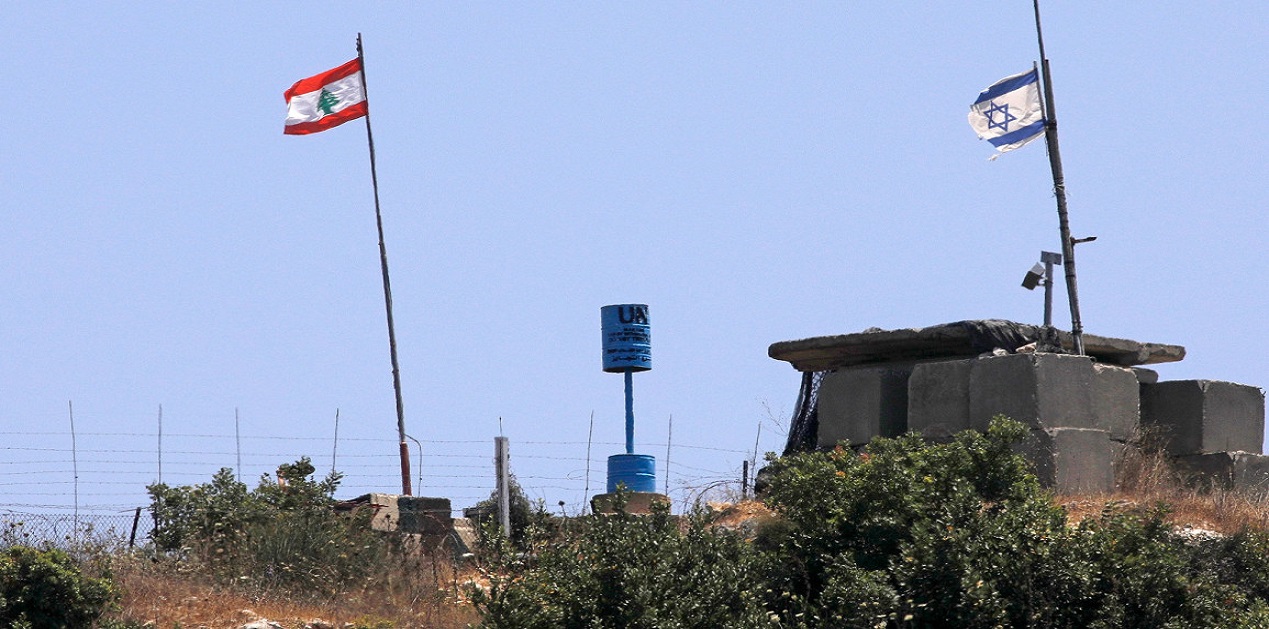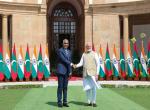Israel currently in midst of ground operation in Gaza Strip is simultaneously engaged in limited war across the Blue Line on its northern frontier with Hezbollah. The near daily exchange of fire that began since Israel Defense Forces (IDF)’s assault on Gaza in October 2023 has raised serious concern about a full-scale conflict in south Lebanon and the wider region. The frequency of strikes and counter-strikes has increased since early 2024. The conflict between IDF and Hezbollah has killed 302 people including 51 civilians in Lebanon between October 2023 and 5 March 2024. In Israel, 10 soldiers and seven civilians including one Indian were killed during the said period.
Hezbollah or the Party of God emerged as Shiite armed group in early 1980s during the course of the Lebanese civil war (1975-1990) to resist against Israel’s occupation and western influence in the state and the region. The 1989 Taif Accords ended the civil war following which, all militia groups disarmed and transformed themselves into political blocs. Although Hezbollah emerged under the shadow of the civil war, the members were allowed to carry weapons and recognised as a resistance group rather than militia with definite aim i.e. expelling the Israeli occupation in south Lebanon. In the post-civil war period, the group emerged as a politico-military organisation with extensive security apparatus, political organization and social services network building its reputation as “a state within a state”. It plays a key role in drafting parliamentary legislations, cabinet selection and government functioning. The public discontent against Hezbollah along with other political stakeholders are brewing over the years due to efforts to preserve the status quo and resisting any reform to transform the economy, society and the political order. Hezbollah’s prominence allows its regional patron, Iran to maintain a sustained influence in Lebanon’s domestic affairs.
Hezbollah’s Small Wars Tactics
In the aftermath of Hamas’ 7 October 2023 attack and Israel’s military response in Gaza Strip, Hezbollah has engaged in limited actions or ‘small wars tactics, designed to keep IDF pre-occupied with low-level violence and showcase commitment to Palestinian issue while preserving the established rules of engagement. Hezbollah in reactive mode is testing IDF’s risk and response thresholds in case of escalating operations on the second front. The Lebanese group has not yet utilised its long range firepower to avoid uncontrolled escalation and took only few calculated risks. The restraint stems from Lebanon’s internal situation facing years of economic mismanagement and large scale corruption complicated by 2020 Beirut port blast, Syrian refugee crisis etc. The presence of US aircraft carriers in the Eastern Mediterranean Sea has dissuaded the group to launch all-out assault. Politically, Hezbollah is an integral component of Lebanese politics and it would not attempt to disrupt the political configuration by pushing the state towards a full scale war with the Jewish state without an effective exit strategy. The fragile Lebanese state has little control over Hezbollah and it is feared that open confrontation would further prolong the political and economic paralysis affecting the Lebanese population for years. Hezbollah's position is somewhat different from Hamas which is estranged from Palestinian Authority (PA). Hezbollah, therefore, has less reason than Hamas to challenge the status quo.
Hezbollah Secretary General Hassan Nasrallah is facing dilemma between the group’s revolutionary credentials and avoiding a full scale war. Nasrallah during his public address on 3 November and 11 November 2023 was careful to avoid committing any major escalation and distanced Hezbollah and the Iranian regime from the Hamas attack to deter any retaliation from Israel or the US. Hassan Nasrallah on 3 November stressed that the 7 October 2023 attack was 100 percent Palestinian in decision-making and execution carried out by Izz al-Din al-Qassam Brigades and other Palestinian factions. He praised the “absolute secrecy” of the operation from the ‘Axis of Resistance’. The Hezbollah leader noted that the Iranian regime openly support resistance in the region; they do not however exercise any form of authority or mandate on these factions and their command.
In light of the humanitarian pause between Israel and Hamas on 22 November 2023, Hezbollah announced its decision to abide by the truce. The resumption of IDF’s ground operation since last week of November 2023 led to steady escalation in the northern border. Hezbollah’s military strategy has focussed on targeting Israeli border posts and townships using mostly short range Burkan and Falaq-1 missiles and anti-tank weapons such as 106 mm recoilless rifles; wire guided AT-3 Sagger missiles; AT-14 Spriggan averaging around five or six, per day. Spy drones have also been employed to monitor IDF positions and Iron Dome anti-missile battery close to Kfar Blum.
Hassan Nasrallah speaking on 14 February 2024 emphasized that the group would continue its border offensive near the Lebanese border and ensure that Israeli residents do not return to their homes until the attacks on Gaza is halted and ceasefire is reached. He noted that Hezbollah’s border offensive has maintained the deterrence formula between Lebanon and Israel. The intervention by the United States (US), the United Kingdom (UK), the European Union (EU) and some Arab states to de-escalate the situation has not succeeded. The US has so far pressurized Tel Aviv not to launch a ground assault in south Lebanon fearing regional escalation. The group has maintained that the goal of the western powers is merely to protect Israel’s security interests.
Hezbollah’s actions have raised worry about Iran’s direct and indirect role in the latest conflagration. The Lebanese group is seen as the ultimate successful embodiment of the application of Iran’s forward defence policy serving as an effective tool of national interest with substantial military and ideological ties. The ties with Hezbollah, Houthis and Hamas have provided the Islamic Republic with an asymmetric strategic advantage. The Islamic Republic for now is hesitant to involve itself in the conflict due to worry about direct confrontation with the US; jeopardising the fragile peace with Saudi Arabia and legitimacy crisis for the regime facing criticisms over economic problems and political crises since the 2022 protests. Tehran’s current strategy is focussed on modulating the threshold; preventing any major escalation and direct or indirect support to Hezbollah for limited cross border raids. Iran has made efforts to contain the numerous low level attacks on US military installations and diplomatic offices by allied groups in Iraq and Syria.
Hamas has already caused heavy damage to the Jewish state’s strategic standing and instilled anti-US and anti-Israeli sentiments throughout the region. Israel’s heavy handed approach in Gaza has slowed down the pace of normalisation with Saudi Arabia. It is uncertain how Tehran would benefit from worsening the conflict. Iran is trying to balance between its regional interests and internal stability. At this stage, the escalation by the group is low key because Israel-Hamas war does not directly impact Iran’s core interests. Therefore, full activation of Hezbollah ‘trigger’ is not considered desirable. The group will nevertheless remain Iran’s most important arsenal and pressure point against Israel.
Israel’s Dilemma
The provocative statements by Hezbollah and Israeli leaders indicate that the brinkmanship could raise the potential for an open conflict. IDF Chief of Staff, Herzi Halevi announced that the intensity of strikes has been increased by IDF and Hezbollah is paying a heavy price. Defence Minister Yoav Gallant notified that the temporary truce and hostage deal under consideration with Hamas would not apply in Lebanon until Israel’s aims are fulfilled i.e. push Hezbollah away from the Israeli border either through diplomatic agreement or by force. Benjamin Netanyahu government is facing intense pressure from around 80,000 citizens evacuated from the border communities to take stern action and push the armed group away from the border. According to 13 February 2024 poll by Maariv newspaper, 71 percent of Israeli respondents favoured large scale military operation against Hezbollah.
Israel has steadily increased the frequency, range of targets and depth inside Lebanon. The IDF initially relied on artillery rockets, fighter jets to retaliate against attacks on border posts and communities. Lately, pre-emptive shelling and air raids deep inside Lebanese territory has surged and in fact attack in Baalbek on 26 February 2024 marked the deepest strike inside Lebanese territory in the recent conflict. Unmanned aerial vehicles (UAVs) have been extensively deployed to attack missile units and spy on members of Hezbollah units before striking their residences and offices using fighter jets or armed drones. Hezbollah leaders, Abbas Raad in November 2023 and Wissam Tawil and Hamas Political Bureau Deputy Chief Saleh Al-Arouri in January 2024 were killed after days of surveillance. Hassan Nasrallah highlighting the threat from Israeli surveillance machinery warned against use of mobile phones and internet connected cameras that are used to collect valuable information and endanger the group.
Israel is already facing tough challenges in Gaza war zone along with dwindling foreign support to continue the brutal assault. IDF has broadly adopted a defensive posture since October 2023 vis-a-vis Hezbollah engaging in controlled escalation. It is highly atypical of IDF to pursue a defensive strategy which usually relies on swiftly taking the conflict into enemy’s territory. Despite the overwhelming public support for full scale war, there is no viable military solution for IDF. The two military options are, firstly, limited ground operation in South Lebanon and secondly, extensive air raids targeting large number of Hezbollah assets and leaders throughout the country. In case of limited ground operation restricted to the area south of Litani River, it could easily spiral into a regional conflict with multiple players targeting Israeli territory and assets. IDF learning for past battle and occupation experiences in Lebanon is unwilling to carry out such a herculean endeavour that could inflict heavy civilian casualties. Hezbollah after the 2006 war managed to emerge itself politically and improved its military capacities, battle tactics, quality and volume of weapons with well-trained fighting force displaying its capacity in Syria’s civil war. It would be difficult for IDF to carry sweeping assault in a hostile territory. In case IDF manages to prevail and exact some form of defeat, Hezbollah fighters will re-fill the area and re-arm themselves after Israel’s departure.
The second option based on extensive air raids and targeted assassinations of Hezbollah members could lead to a tactical setback for the Lebanese group. The group however, would not face any major existential challenge and will bounce back with Iran and Syria’s backing. Therefore, there is no possibility of long-term stability in the northern region and it would likely discourage Israelis to return to their homes. The Israeli residents after the audacious infiltration and mass killings by Hamas on 7 October fear a repeat by Hezbollah, a relatively better equipped and organized force. In case of a full scale conflict, it could be devastating for both states. Israel has clear military superiority. The nature of warfare is however changing. It is estimated that Hezbollah has large number of sophisticated armed drones and more than 150,000 missiles that could overwhelm Iron Dome system similar to Hamas’ strategy creating another ‘shock and awe’ inside Israeli territory. The 7 October attack has led to a major re-thinking within Israeli polity and society and disrupted its sense of security and the image of invincibility. Israel in case it opts for a diplomatic solution to thwart the group’s attacks, the communities in the north are unwilling to completely rely on such a fragile peace and return home. Israel’s dilemma is that it cannot accept the status quo until around 80,000 citizens remains internally displaced. At the same time, it is aware of the risks in case of heavy fighting and full scale conflict.
Miscalculation, therefore remains a constant danger and in case a missile attack by Hezbollah causes significant Israeli civilian deaths or IDF’s intrusions in Lebanese territory is interpreted as all-out war; the situation could get out of control. Although unlikely, there is always a possibility that Iran could activate its “Axis of Resistance” allies in Lebanon, Syria, Iraq and Yemen for all out confrontation. Iran could promote other radical groups if Hamas’ grip is significantly weakened in Gaza. The optimists within Israel see the land operation and the possibility of full-scale war against Hezbollah with the US help as an historic opportunity to “fix” and reshape the region heavily weakening Iran. Therefore, a pre-emptive action by Israel cannot be ruled. IDF could take recourse to false flag operations to drag the US into a direct conflict with Iran. US officials have privately raised worry about Israel seeking American made weapons for a war on Lebanon risking civilians in both states and threaten confrontation with Iran. US Special Envoy Amos Hochstein visiting Beirut on 4 March 2024 dismissed temporary ceasefire calling it insufficient. He insisted that diplomatic solution is the only way to end the hostilities requiring a lasting security arrangement between Israel and Lebanon.
For Benjamin Netanyahu facing all time low popularity and weak Hamas that could take years to bounce back, a crushing assault against Hezbollah could re-instate ‘Mr. Security’ image and resuscitate his political career. In case Israel is not willing for ceasefire in Gaza, the border with Lebanon will remain tense. The public pressure could force the government to opt for full scale military operation, it will however not lead to safeguarding Israel’ security interests in the long-term and in fact could further disrupt regional stability.
Impact on Indian Workforce
The strikes by Hezbollah in Margaliot in the Galilee region on 4 March 2024 killed one Indian, Pat Nibin Maxwell and injured two others, Bush Joseph George and Paul Melvin bringing to light the direct ramification of the unstable security regional environment on the Indian diaspora. In case of further escalation, the diaspora community serving in region could be at high risk. Indian government following the death has issued an advisory requesting its citizens working or visiting border areas in north and south Israel to relocate to safe areas within Israel. The cancellation of work permits for Palestinians has propelled Israeli firms to opt for Indian workers. Israeli government on 31 January 2024 approved the entry of 10,000 Indians and the quota has been increased to 30,000 to 50,0000 based on the demands of the construction industry. In case the conflict escalates in northern and southern region, the potential danger on welfare of Indian workforce would remain. Lastly, it needs to be seen whether there is a likelihood of any political fallout for India due to the complete replacement of Palestinian labour by Indians.
(The paper is the author’s individual scholastic articulation. The author certifies that the article/paper is original in content, unpublished and it has not been submitted for publication/web upload elsewhere, and that the facts and figures quoted are duly referenced, as needed, and are believed to be correct). (The paper does not necessarily represent the organisational stance... More >>
Image Source: https://www.newarab.com/sites/default/files/styles/large_16_9/public/media/images/228127B4-B431-4248-896D-CCED12E485C0.jpg?h=d1cb525d&itok=b6wb-UYB











Post new comment